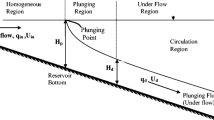Abstract
Montana flume is derived from Parshall flume by eliminating diverging part and throat. The mass transfer of oxygen from the atmosphere into the water is known as aeration. The dissolved oxygen (D.O.) concentration in the water body determines water quality. The experiment was performed on six different Montana flumes fixed in a tilting prismatic rectangular channel. Experimental observations were used to develop classical and machine learning models to predict Montana flume aeration efficiency. The developed models are namely multi nonlinear regression (MNLR), adaptive neuro-fuzzy inference system (ANFIS), and artificial neural network (ANN). The models were tested, and the results show that all these three developed models perform very well. However, ANN gives better results than other models as it has the highest cc and lowest rmse values. According to the sensitivity analysis results, the Reynolds number (Re) was the most crucial input element in determining the aeration efficiency of the Montana flume in the case of dimensionless datasets. However, discharge per unit width (q) is found to be of relative significance in the case of dimensional datasets.







Similar content being viewed by others
References
W.K. Lewis, W.G. Whitman, Principles of gas absorption. Ind. Eng. Chem. 16(12), 1215–1220 (1924)
Parshall, Ralph Leroy. Measuring water in irrigation channels. No. 1683. U.S. Department of Agriculture, 1941.
R.G. Zytner, Z.G. Rahmé, M. Labocha, Oxygen uptake at parshall flumes. Can. J. Civ. Eng. 25(4), 769–776 (1998)
N.K. Tiwari, P. Sihag, Prediction of oxygen transfer at modified parshall flumes using regression models. ISH J. Hydraul. Eng. 26(2), 209–220 (2020)
Sangeeta, et al. Machine learning model development for predicting aeration efficiency through parshall flume. Eng. Appl. Comput. Fluid Mech. 15(1): 889–901 (2021).
S.R. Sangeeta, N.K. Tiwari, Aeration efficiency evaluation of modified small parshall flume using M5P and adaptive neuro-fuzzy. Sustain. Eng. Proc. EGRWSE 30, 243–252 (2019)
O.F. Dursun, An experimental investigation of the aeration performance of parshall flume and venturi flumes. KSCE J. Civ. Eng. 20(2), 943–950 (2016)
N.K. Tiwari, Evaluating hydraulic jump oxygen aeration by experimental observations and data driven techniques. ISH J. Hydraul. Eng. 27(sup1), 601–615 (2021)
A. Baylar, M.E. Emin, T. Bagatur, An experimental investigation of aeration performance in stepped spillways. Water Environ. J. 20(1), 35–42 (2006)
J.S. Gulliver, J.R. Thene, A.J. Rindels, Indexing gas transfer in self-aerated flows. J. Environ. Eng. 116(3), 503–523 (1990)
Luxmi, K. M., Tiwari, N. K., Ranjan S. Application of soft computing approaches to predict gabion weir oxygen aeration efficiency. ISH J. Hydraul. Eng.: 1–15 (2022)
M. Kumar, N.K. Tiwari, S. Ranjan, Experimental study on oxygen mass transfer characteristics by plunging hollow jets. Arab. J. Sci. Eng. 46(5), 4521–4532 (2021)
A. Apha, W.E.F., 2005. Stand. Methods Exam. Water Wastewater 21, 258–259 (2005)
P.R. Wormleaton, C.C. Tsang, Aeration performance of rectangular planform labyrinth weirs. J. Environ. Eng. 126(5), 456–465 (2000)
Bostan, Tuba, et al. “The effect of hydraulic jump on the aeration efficiency.” (2013).
M. Markofsky, H. Kobus, Unified presentation of weir-aeration data. J. Hydraul. Div. 104(4), 562–568 (1978)
Funding
The author declares that no funds, grants, or other support were received during the preparation of this manuscript.
Author information
Authors and Affiliations
Contributions
All authors contributed to the study conception and design. Material preparation, data collection and analysis were performed by AT, NKT, CSPO and SR. The first draft of the manuscript was written by AT and all authors commented on previous versions of the manuscript. All authors approved the final manuscript.
Corresponding author
Ethics declarations
Conflict of interest
The authors have no relevant financial or non-financial interests to disclose.
Additional information
Publisher's Note
Springer Nature remains neutral with regard to jurisdictional claims in published maps and institutional affiliations.
Rights and permissions
Springer Nature or its licensor (e.g. a society or other partner) holds exclusive rights to this article under a publishing agreement with the author(s) or other rightsholder(s); author self-archiving of the accepted manuscript version of this article is solely governed by the terms of such publishing agreement and applicable law.
About this article
Cite this article
Tiwari, A., Ojha, C.S.P., Tiwari, N.K. et al. Montana Flume Aeration Performance Evaluation with Machine Learning Models. J. Inst. Eng. India Ser. A 104, 175–186 (2023). https://doi.org/10.1007/s40030-022-00706-5
Received:
Accepted:
Published:
Issue Date:
DOI: https://doi.org/10.1007/s40030-022-00706-5




